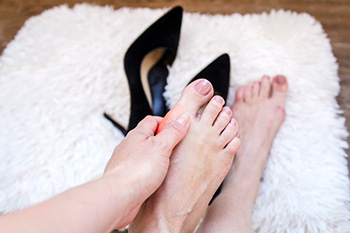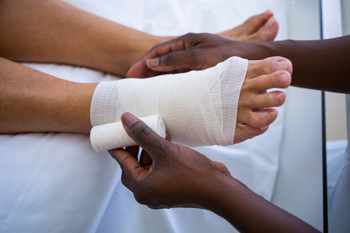
Women can feel comfortable wearing high heels in various settings, from casual to formal occasions. The appeal of wearing this type of shoe may include making an individual look taller while enhancing the shape of the legs. Despite this attraction to wearing high heels, they may not be the best for the feet when they are frequently worn. The higher the heel, the greater the impact they can have on the ball of the foot. The heel height can reduce the range of motion in the ankle and may decrease support in the heels. This may cause ankle instability and result in enduring an ankle fracture or sprain. Bunions and hammertoes are common ailments among those who wear high heels daily. The toe areas of high heels can be narrow, causing the toes to shift together and possibly leading to unwanted foot conditions. High-heel wearers may want to compromise and choose a shoe with a wider toe box and a lower heel. If you would like to have additional knowledge about how the feet are affected by wearing high heels, it is suggested that you confer with a podiatrist.
High heels have a history of causing foot and ankle problems. If you have any concerns about your feet or ankles, contact one of our podiatrists from Carolina Foot & Ankle Specialists. Our doctors can provide the care you need to keep you pain-free and on your feet.
Effects of High Heels on the Feet
High heels are popular shoes among women because of their many styles and societal appeal. Despite this, high heels can still cause many health problems if worn too frequently.
Which Parts of My Body Will Be Affected by High Heels?
- Ankle Joints
- Achilles Tendon – May shorten and stiffen with prolonged wear
- Balls of the Feet
- Knees – Heels cause the knees to bend constantly, creating stress on them
- Back – They decrease the spine’s ability to absorb shock, which may lead to back pain. The vertebrae of the lower back may compress.
What Kinds of Foot Problems Can Develop from Wearing High Heels?
- Corns
- Calluses
- Hammertoe
- Bunions
- Morton’s Neuroma
- Plantar Fasciitis
How Can I Still Wear High Heels and Maintain Foot Health?
If you want to wear high heeled shoes, make sure that you are not wearing them every day, as this will help prevent long term physical problems. Try wearing thicker heels as opposed to stilettos to distribute weight more evenly across the feet. Always make sure you are wearing the proper shoes for the right occasion, such as sneakers for exercising. If you walk to work, try carrying your heels with you and changing into them once you arrive at work. Adding inserts to your heels can help cushion your feet and absorb shock. Full foot inserts or metatarsal pads are available.
If you have any questions please feel free to contact our offices located in Mount Pleasant and Charleston, SC . We offer the newest diagnostic and treatment technologies for all your foot and ankle needs.






